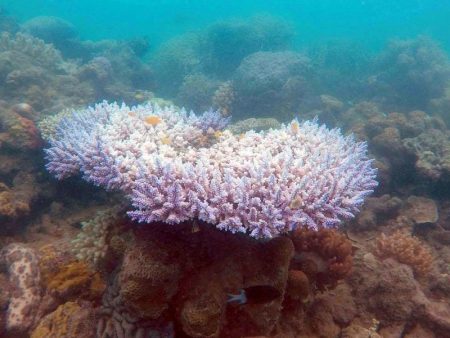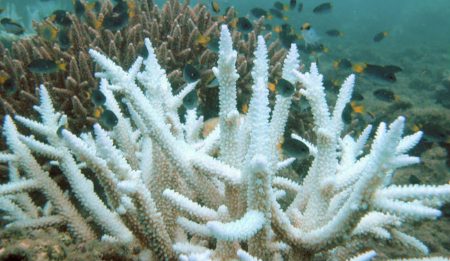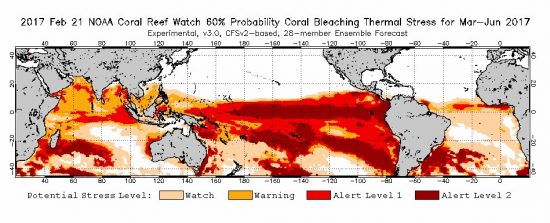February 28, 2017 – My brother got into a conversation with a resident of his building last week who had just come back from Australia, and reported that the Great Barrier Reef is just doing fine. My brother begged to differ and dropped me a note asking me if I had gathered evidence about the Great Barrier Reef that would dispel his concerns and refute the argument of his neighbour.
I’m not sure what sources my brother’s neighbour was citing to state his opinions on the subject. Was it personal observation that led him to make this declaration? Or was it hearsay or information provided by the Australian government that led him to this conclusion? Maybe his source was former Prime Minister Tony Abbott who single-handedly eviscerated Australia’s climate change research budget while he was in office. Or maybe it was the current PM Malcolm Turnbull who is on and off again about climate change and what activist policies the government can take.
One thing for sure, the science says otherwise.
In the latest article posted at Smithsonian.com, the website for America’s Smithsonian Institution, 2016 was “the worst die-off in the reef’s history.” The worst bleaching happened when sea temperatures hit record highs in March and April of 2016. The damage saw 63% of corals in the northern and 6% in the central reef die. Bleaching does not necessarily indicate that the coral cannot recover, but what is needed to ensure a return to normal conditions is cooler ocean water.

The indicators are not good for the reef because measured surface temperatures indicate more warming, not less. In the latest Australian government briefings on the reef, it notes that temperatures are even warmer than last year when bleaching began. Spot checks of six reef habitats in recent weeks show 60% bleaching in the northern portions of the reef and in areas previously not hit by last year’s events.
Who or what is to blame?
Climate change and periodic El Ninos are both cited. A suspected new El Nino is starting in the equatorial Pacific right now and all indications point to it being as big and prolonged as the last one which developed in 2014, continued through 2015 and finally subsided early in 2016. That El Nino event not only damaged the reef but played havoc with weather across the world.
In a new report by Michael Le Page, appearing in New Scientist, he writes about an unprecedented four-year bleaching of coral reefs around the world with the Great Barrier Reef being the number one exhibit showing the extent of the damage. Le Page notes that the La Nina cooling in 2016 has not produced cooler surface temperatures as in past cycles. The result, the National Oceanic and Atmospheric Administration (NOAA), through satellite monitoring, is predicting significant bleaching and coral deaths in 2017.
NOAA released the satellite map seen below on February 21. It indicates forecasted coral bleaching from thermal stress for the period from March to June of this year. Note the areas off Australia’s northeastern coast are, either at Alert Level 1 or 2 in terms of future bleaching.
In 2016 observations, NOAA (which may see its budget cut dramatically by President Trump) reported 93% of the Great Barrier Reef experiencing bleaching as of April of that year. I assume this satellite data was shared with the Australian government and its people. I gather, however, that the message didn’t reach some of those visiting the country.
One must point out that the second and non-physical culprit to be blamed for the decline of the Great Barrier Reef, is the government of Australia, itself. Australia says it has a 35-year plan to protect the reef. Published in 2015 it states that the government is dedicated to improving the reef every decade to restore it to its past extent and health by 2050. The current reef damage points to a far different outcome both in the near and far future. And when you look at Australia’s maritime policies regarding shipping lanes that cross the reef from Queensland’s super port at Gladstone, it is highly unlikely that this or any future Australian government will have a positive impact on the corals and the ecosystem the Great Barrier Reef supports.

So what can Australia do to protect the reef and restore it?
The Reef Trust formed by the government is focused on ways to eliminate sediments from runoff, culling coral predators like the crown-of-thorns starfish, and improving Australia’s coastal habitats to improve water quality. But what the government cannot do directly is stop an El Nino from happening. Over the long term, if Australia were to curb its domestic use and export of coal for use in thermal power generation and steel production (coal is a significant source of greenhouse gas emissions), it could indirectly impact the reef’s future. But mega coal mines, supported by the national and state governments in Australia, continue to be developed.









